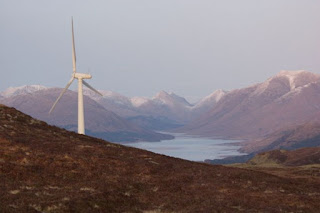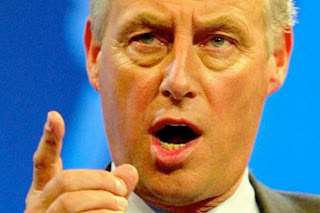 |
| The map shows the locations of geological hotspots that could be tapped for energy throughout the UK. The Eden Project's Tim Smit is behind the idea. |
As Britain signs an agreement with Iceland to cooperate on geothermal power and offshore drilling, a new report says hot rocks could power one fifth of UK homes.
The bilateral agreement follows talks last month between Energy Minister Charles Hendry and Icelandic power sector leaders. The MoU, which Mr. Hendry signed with his Icelandic counterpart Oddný G. Harðardóttir yesterday, will strengthen the two countries’ relationship on energy issues such as interconnectors and the development of their oil and gas industries, including offshore drilling.
Charles Hendry said: “Today’s agreement will help pave the way for a closer relationship with Iceland, which I hope can yield significant benefits for the UK, including the development of geothermal power, greater use of interconnectors to transport energy under the sea, and developing oil and gas resources."
The two countries have pledged to exchange information on the development of the deep geothermal sector in the UK, including the supply of heat to district heating networks.
They will also explore the possibility of developing electricity interconnection between Iceland and the UK, and their respective Ministries for International Development will collaborate on developing renewable energy projects in developing countries with a special focus on East Africa.
Geothermal could power one fifth of homes
The new report on the UK potential for geothermal energy, by Sinclair Knight Merz and commissioned by the Renewable Energy Association, concludes that it should be possible for geothermal energy to provide the UK with a cumulative benefit of 5,000 gigawatt-hours (GWh) of electricity and 32,000 GWh of heat by 2030. This is power equivalent to nine nuclear reactors.
Deep geothermal systems generate electricity from water heated by rock deep underground to create steam that drives conventional turbines.
The report’s author, Mr Tim Jackson, a Senior Geothermal Engineer at SKM explained that “SKM has used internationally recognised methods to assess the most promising resources and concluded that there is potential for 9,500MW of electrical power and 100,000MW of heat for projects with a 25 year lifetime.”
Mr Jackson continued, “SKM’s analysis suggests that a feed-in tariff level of approximately £300/MWh for electrical generation and combined heat and power projects is required to develop these geothermal projects in the UK. This is approximately equal to five Renewable Obligation Certificates (ROCs) per MWh.”
“For heat-only projects a Renewable Heat Incentive of £30 to £70/MWh is needed.”
“The UK already has world-leading drilling skills and these could be applied to support geothermal projects and develop new techniques to make Engineered Geothermal System power plants more commercially attractive,” he added. “With the right skills and supporting mechanisms in place, the resulting energy production could make a significant contribution towards achieving the UK’s sustainable energy needs as well as enhancing the UK’s capabilities in sustainable energy.”
A geothermal project in Newcastle led by Paul Younger has been drilling for several months and is about to reach a point at which it can tap into hot rocks at 200°C, which will be used for a district heat main.
Key findings of the report include:
- The resource is widely spread around the UK with ‘hotspots’ in Cornwall, Weardale, Lake District, East Yorkshire, Lincolnshire, Cheshire, Worcester, Dorset, Hampshire, Northern Ireland and Scotland
- Cost reduction potential is exceptionally high
- Deep geothermal resources could provide 9.5GW of baseload renewable electricity – equivalent to nearly nine nuclear power stations – which could generate 20% of the UK’s current annual electricity consumption
- Deep geothermal resources could provide over 100GW of heat, which could supply sufficient heat to meet the space heating demand in the UK
- Despite this significant potential, the UK support regime is uncompetitive with other European countries.
The geothermal industry is waiting for the results of the Renewable Obligation Binding Review, and lobbying for support to be higher than two ROCs, which it says will be too low to support domestic investment. This is because it is a new technology in its development phase, like the marine energy industry.
Dr Ryan Law, Chair of the REA Deep Geothermal Group said: “We don’t want to be left out of a global industry which is estimated to be worth £30 billion by 2020. We could be at the forefront of this industry given the strength of British engineering skills.” The industry has synergies with the oil, coal and gas industry on account of its need for expertise in geology and drilling.
Tim Smit, the man behind the Eden Project, is planning to build a geothermal heat and power station at the Eden Project, and says in a foreword to the report: “it is the platform for the birth of a new industry; for a small investment today we could be creating something that our grandchildren will thank us for.”
The report recommends that projects could be developed close to areas of large heat demand, such as hospitals or municipal buildings.
Support for geothermal power would cost an estimated £11 million a year, which is the equivalent of adding less than 50p to the average household electricity bill.
Where are the resources?
Suitable geology is not found throughout the UK, but only in particular places. The resources and their locations identified for the report are illustrated in the map above and have been summarised by Cluff Geothermal as:
Cornwall and the South West
HEAT: 13,000 MWth - 6.5 million homes annual heat demand
POWER: 4,000 MWe (equivalent to 3.3 nuclear power plants)
The North East
HEAT: 9,000 MWth - 4.5 million homes annual heat demand
POWER: 4,000 MWe (equivalent to 3.3 nuclear power plants)
The Lake District
HEAT: 8,000 MWth - 4 million homes
POWER: 2,300 MWe (equivalent to 1.9 nuclear power plants)
Wessex Basin
HEAT: 33,000 MWth - 16.5 million homes
Cheshire Basin
HEAT: 14,000 MWth - 7 million homes
East of England
HEAT: 12,000 MWth - 6 million homes
Worcester Basin
HEAT: 6,700 MWth - 3.35 million homes
Larne Basin
HEAT: 1,000 MWth - 500,000 homes.
Story: David Thorpe, News Editor









